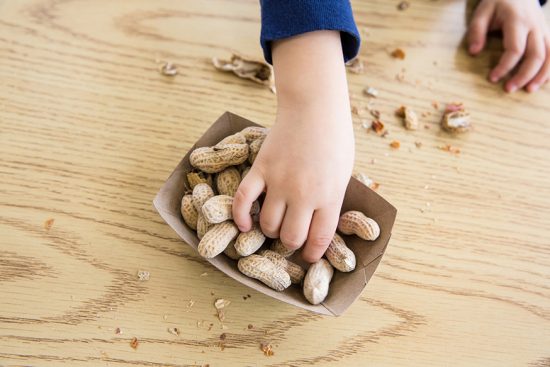With food allergies and intolerances increasingly common among little ones, we look at how to spot the signs and what to do to help your child.
Allergy symptoms
Food allergies affect 6 to 8% of children in the UK and are caused when the immune system reacts to large molecules found in food.
The most common foods that cause allergic reactions are cow’s milk, nuts, eggs, wheat, seeds, fruit, fish and shellfish.
It can be confusing trying to figure out if a child has an allergy so it’s important for parents to be aware of the signs of allergies.
In rare cases, an allergy can lead to a severe allergic reaction, called anaphylaxis, which can be life-threatening.
This affects the whole body and usually develops within minutes of coming into contact with something you’re allergic to.
The symptoms of anaphylactic shock include those listed above, as well as swelling of the throat and mouth, difficulty breathing, lightheadedness, confusion, blue skin or lips, collapsing and losing consciousness.
Call 999 immediately if you suspect your child is in anaphylactic shock.
Cows’ Milk Allergy (CMA), also called Cows’ Milk Protein Allergy (CMPA), is one of the most common childhood food allergies. Between 2% and 7.5% of babies under one are estimated to have CMA.
The NHS says it typically develops when cows’ milk is first introduced into your baby’s diet, either in formula or when your baby starts eating solids.

It can also affect exclusively breastfed babies because of cows’ milk from mum’s diet passing to their baby.
Sophia Stone, mum to Jamie and Gemma, and member of NCT Mid-Sussex branch, says: ‘From about two weeks old, Gemma was very unsettled, snuffly, spitting up lots and she had eczema. But my biggest concern was her horrendous nappies, which were green, mucusy and very smelly.’
‘I tried reducing and then eliminating my dairy intake and within 48 hours she was like a different baby. This was as good as a formal CMA diagnosis for us.’
As Sophia decided to follow a dairy-free diet, her doctor recommended other sources of calcium, such as sardines, green vegetables and a breastfeeding supplement.
A dairy free diet can seem overwhelming, but it’s actually straightforward when you get your head
around it
She eventually tried to give her daughter various alternative milks, including hemp, but Gemma wasn’t keen so she continued to breastfeed. And, after baby led weaning, Gemma ate the same dairy-free meals as her mum.
‘We had a solution which worked and I actually feel better for not having dairy in my diet’.
Vivienne Cruddace, mum to Toby and Molly and NCT Joint Branch Coordinator for Aberdeen, also has experience of CMA with her daughter.
‘Unfortunately there’s no way to officially diagnose CMA in small babies. The best test is going dairy free, waiting for an improvement, then having some dairy to see if there’s a reaction.’
‘I’d say see a breastfeeding counsellor as lots of CMA symptoms can actually be caused by breastfeeding issues, so it’s good to eliminate these first.’
Allergies to nuts, nut
products and some seeds affect 1 to 2% of people.
Your child has a higher risk of developing a peanut allergy if they already have an allergy such as eczema or a diagnosed food allergy.
There’s also more chance if there’s a history of allergies in their immediate family, including asthma, eczema or hay fever.

If you are concerned about a potential allergic reaction, it’s definitely worth talking to your GP or health visitor before you give peanuts or food containing peanuts to your little one for the first time. They may be able to offer advice or reassurance.
While lots of children do outgrow allergies to milk or eggs, it’s important to acknowledge that peanut allergies are, unfortunately, generally lifelong.
Breastfeeding your baby exclusively for the first six months will help lower their risk of allergies.

If you’re not breastfeeding and have concerns about allergies, ask your GP or health visitor for advice on what kind of formula to give.
The advice from the World Health Organization is not to introduce solids before baby is six months old.
If you think your child has had an allergic reaction, see your GP as they can help determine whether it’s likely to be an allergy or caused by another condition.
It’s a good idea to offer milk, eggs, wheat, nuts, seeds and fish one at a time so you can spot potential reactions
They’ll be able to offer advice and treatment to manage the allergy.
If it’s severe or hard to determine what’s causing the reaction, they may refer you to an allergy specialist for testing or treatment advice.
The allergy specialist may suggest a skin-prick test or blood test. They will then advise you on cutting the food from your child’s diet and tell you whether they want to re-test at regular intervals.
They sometimes do things like milk ladders (which means dividing milk products into groups from those containing small amounts of cooked cow’s milk through to large amounts of dairy products and gradually trying them).
Or they may suggest an egg challenge to slowly reintroduce the food and see if the child can tolerate more of the trigger food.
A food intolerance is difficulty digesting certain foods and having an unpleasant physical reaction. A food intolerance isn’t the same as an allergy as no allergic reaction takes place.
There are no tests for food intolerances. The only way to know if you have one is to monitor your symptoms and the food you eat – and try eliminating a suspected trigger and then reintroducing it.
Intolerance symptoms
These are different to the symptoms of allergies and include:
One of the most common intolerances is to lactose, which is a type of sugar mainly found in milk, yoghurts and soft cheeses.
Lactose intolerance isn’t the same as a milk or dairy allergy as these are caused by your immune system having a reaction to a certain type of food.
Lactose intolerance, on the other hand, means a person does not produce the enzyme, or enough of the enzyme, required to digest lactose.
This means acids and gases are produced, making your tummy feel uncomfortable.
There are medical tests for this, including the hydrogen breath test. But they’re not always useful as they’d also be positive in most breastfed babies under three months as it’s common to find sugar in their stools.

If you’re breastfeeding, the amount of lactose in your milk will depend on how much lactose you’re consuming. So some mums decide to try a lactose-free diet. Speak to your GP about this.
While there are lactose-free baby formulas available, there’s little evidence about their effect.
It’s also worth noting lactose intolerance can be temporary and last a few days or weeks after a tummy bug, after which time it’s safe to gradually reintroduce milk and dairy products.
The symptoms of an intolerance usually occur several hours after eating
the food, a larger amount of food is needed to trigger an intolerance and they’re
never life-threatening,
unlike allergies.
One of the first steps in working out if your child has an intolerance is to keep a daily diary of their food or milk intake, as well as symptoms.
Some children who are lactose intolerant may be able to consume small amounts of lactose without experiencing symptoms, so you might want to experiment.
If you think your child has a food intolerance, speak to your GP. You may be referred to a dietician for nutritional advice because it’s important for young children to have certain nutrients in their diet.
Allergies and intolerances can be worrying, frustrating, stressful and restrictive.
Sarah McKay, from Newbury and District NCT branch, has experience of allergies with her son David.
She says: ‘I felt at times like an epic failure and quite alone. I felt guilty that he didn’t get to eat what he wanted like his friends.’

‘I felt sad that he learnt quickly to tell people that some food made his tummy bad and he couldn’t share his friends’ birthday cakes.’
She added: ‘Even shopping was a nightmare as we had to check every label even for “safe” foods as ingredients changed often.’
While it’s tough for parents and little ones alike, it’s good to remember most allergies and intolerances are mild and they can be managed. And most don’t last forever.
Some parents also say their child doesn’t miss the food because they’ve never really had it in their diet.
Food manufacturers are also getting better at catering for people with food allergies, so there’s more choice of dairy-free, lactose-free or nut-free foods.
The best piece
of advice would be to trust your instincts
Vivienne says she found it invaluable talking to other parents who were going through the same thing in online groups. Local mums were also able to tell her about the best dairy-free eating spots and vegan cake makers!
Sarah explains: ‘I was very lucky to have people who would make the extra effort to cater for David at parties and save wrappers for me so I could check ingredients.’
‘I knew something wasn’t right, but I wasn’t confident as a new mum to push it. Use online resources for information gathering, but also make sure you seek professional help.’
NCT information on introducing solid foods
NCT helpline for questions on all aspects of feeding
0300 330 0700